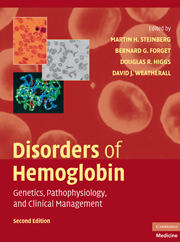Book contents
- Frontmatter
- Contents
- List of Contributors
- Foreword, by H. Franklin Bunn
- Preface
- Introduction, by David J. Weatherall
- SECTION ONE THE MOLECULAR, CELLULAR, AND GENETIC BASIS OF HEMOGLOBIN DISORDERS
- SECTION TWO PATHOPHYSIOLOGY OF HEMOGLOBIN AND ITS DISORDERS
- SECTION THREE α THALASSEMIA
- SECTION FOUR THE β THALASSEMIAS
- SECTION FIVE SICKLE CELL DISEASE
- 19 Clinical and Pathophysiological Aspects of Sickle Cell Anemia
- 20 Sickle Cell Pain: Biology, Etiology, and Treatment
- 21 Hemoglobin SC Disease and Hemoglobin C Disorders
- 22 Sickle Cell Trait
- 23 Other Sickle Hemoglobinopathies
- SECTION SIX OTHER CLINICALLY IMPORTANT DISORDERS OF HEMOGLOBIN
- SECTION SEVEN SPECIAL TOPICS IN HEMOGLOBINOPATHIES
- SECTION EIGHT NEW APPROACHES TO THE TREATMENT OF HEMOGLOBINOPATHIES AND THALASSEMIA
- Index
- Plate section
- References
23 - Other Sickle Hemoglobinopathies
from SECTION FIVE - SICKLE CELL DISEASE
Published online by Cambridge University Press: 03 May 2010
- Frontmatter
- Contents
- List of Contributors
- Foreword, by H. Franklin Bunn
- Preface
- Introduction, by David J. Weatherall
- SECTION ONE THE MOLECULAR, CELLULAR, AND GENETIC BASIS OF HEMOGLOBIN DISORDERS
- SECTION TWO PATHOPHYSIOLOGY OF HEMOGLOBIN AND ITS DISORDERS
- SECTION THREE α THALASSEMIA
- SECTION FOUR THE β THALASSEMIAS
- SECTION FIVE SICKLE CELL DISEASE
- 19 Clinical and Pathophysiological Aspects of Sickle Cell Anemia
- 20 Sickle Cell Pain: Biology, Etiology, and Treatment
- 21 Hemoglobin SC Disease and Hemoglobin C Disorders
- 22 Sickle Cell Trait
- 23 Other Sickle Hemoglobinopathies
- SECTION SIX OTHER CLINICALLY IMPORTANT DISORDERS OF HEMOGLOBIN
- SECTION SEVEN SPECIAL TOPICS IN HEMOGLOBINOPATHIES
- SECTION EIGHT NEW APPROACHES TO THE TREATMENT OF HEMOGLOBINOPATHIES AND THALASSEMIA
- Index
- Plate section
- References
Summary
INTRODUCTION
The Genotypic Complexity of Sickle Cell Disease
The sickle hemoglobin gene (HBB glu6val) and β thalassemia alleles are often geographically coincident. Consequently, compound heterozygotes with HbS–β thalassemia are commonplace. The incidence of this genotype is dependent on the populations' ratio of carriers of an HbS gene to carriers of β thalassemia. In the United States, and in Africa where the HbS predominates, sickle cell anemia (homozygous for HBB glu6val) is the prevailing genotype of sickle cell disease. Wherever β thalassemia is more frequent than sickle cell trait (HbAS) – Greece, Italy, and other Mediterranean countries are examples – HbS–β thalassemia predominates. Some β thalassemia variants, such as δβ thalassemia and Hb Lepore and gene deletion hereditary persistence of fetal hemoglobin (HPFH), can interact with HbS producing different interesting phenotypes. α Thalassemia is present in 30% of African Americans with sickle cell anemia and might be even more common in some populations from the Middle East and Indian subcontinent. Individuals with sickle cell anemia–α thalassemia have distinctive hematological and clinical features. Compound heterozygotes of HbS with other mutant α- or β-globin genes are also present in any population with a high prevalence of HbS. Depending on the other globin gene mutation, these conditions can resemble the clinically benign HbAS or have a phenotype with hemolytic anemia and vasoocclusive complications. Rare variants, often with intriguing phenotypes, have both the sickle mutation and an additional mutation in the same β-globin gene.
- Type
- Chapter
- Information
- Disorders of HemoglobinGenetics, Pathophysiology, and Clinical Management, pp. 564 - 586Publisher: Cambridge University PressPrint publication year: 2009
References
- 3
- Cited by



